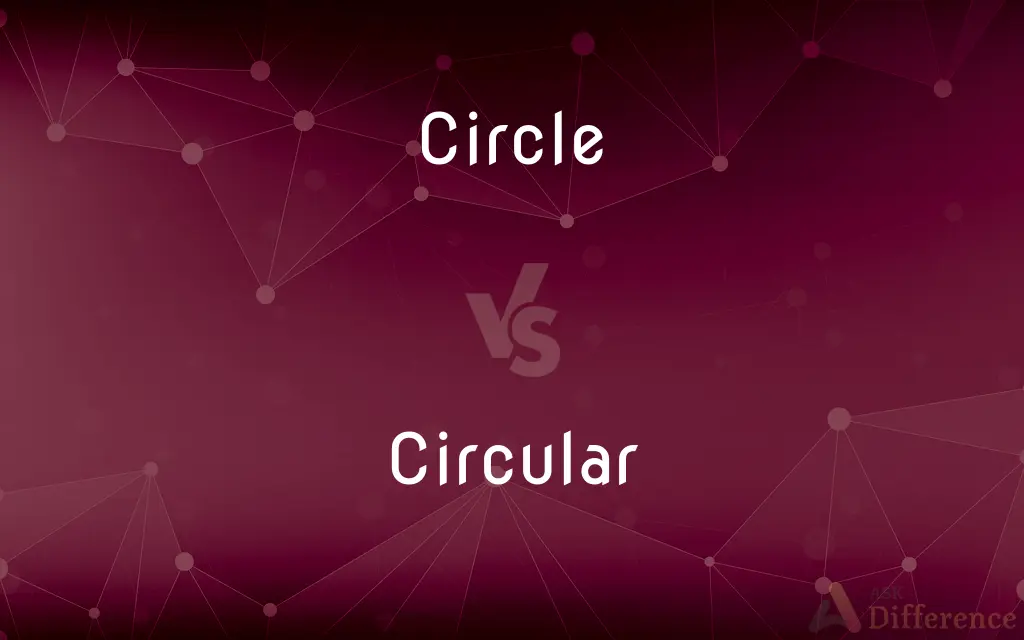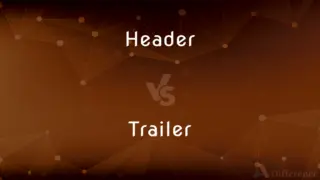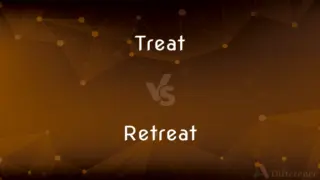Circle vs. Circular — What's the Difference?
By Fiza Rafique & Urooj Arif — Updated on March 22, 2024
A circle is a geometric shape consisting of all points in a plane equidistant from a given point, while circular describes anything having the shape of or resembling a circle, often used as an adjective to denote shape or movement.

Difference Between Circle and Circular
Table of Contents
ADVERTISEMENT
Key Differences
A circle is a fundamental geometric concept defined by its perfect symmetry around a central point, known as the center. On the other hand, circular is an adjective that characterizes objects, movements, or arrangements that mimic the shape or properties of a circle. Circular can describe the physical shape of an object, like a circular table, or metaphorically suggest a pattern of reasoning that returns to its starting point, as in a "circular argument."
The term circle serves as a precise mathematical term, allowing for clear and specific discussions about its properties and applications in various fields, including geometry, physics, and engineering. Circular, however, has a broader usage, applying to physical objects and abstract concepts. For example, circular reasoning, where the conclusion of an argument is used as its premise, illustrates the term's application beyond the physical world, highlighting its versatility.
In design and architecture, the distinction between circle and circular becomes particularly relevant. A circle may refer to the specific plan or shape intended for a structure, focusing on geometric precision. Circular, however, can describe the overall form or motif, such as circular patterns or themes that recur throughout a design, emphasizing the aesthetic or functional aspects derived from circular shapes.
The concept of a circle is often used in teaching fundamental principles of geometry, such as pi (π), the ratio of a circle’s circumference to its diameter. This constant is crucial in calculations involving circular shapes and has profound implications in various scientific disciplines. Circular concepts, by extension, find practical applications in everyday life, engineering, and the natural world, such as in circular orbits of celestial bodies, indicating how these mathematical principles manifest in observable phenomena.
The transition from the abstract concept of a circle to the practical applications of circular shapes underscores the relationship between theoretical mathematics and its real-world applications. While a circle is an idealized form studied for its purity and mathematical relationships, circular objects and patterns demonstrate how these principles are utilized in design, nature, and technology, bridging the gap between abstraction and practicality.
ADVERTISEMENT
Comparison Chart
Definition
A geometric shape with all points equidistant from a center.
Adjective describing something in the shape of or resembling a circle.
Usage
Specific, referring to the geometric figure.
Broad, applying to shapes, movements, and abstract concepts.
Applications
Geometry, physics, engineering.
Design, architecture, reasoning patterns.
Examples
The design of a circular track for athletics, the plan for a roundabout.
Circular reasoning, circular patterns in design.
Focus
Mathematical properties and precision.
Shape, motif, and functional or aesthetic qualities derived from circles.
Compare with Definitions
Circle
Represents infinity in geometry.
A circle has an infinite number of points.
Circular
Involving circular motion.
The planets follow circular orbits.
Circle
A perfect round shape.
A clock's face is an example of a circle.
Circular
Shaped like a circle.
They sat at a circular table.
Circle
Defined by its radius or diameter.
The circle was drawn with a radius of 5 cm.
Circular
Describing indirect reasoning.
The debate was stuck in circular arguments.
Circle
Basis for calculating area and circumference.
The area of a circle is πr².
Circular
Used in design for harmony.
The logo features a circular pattern.
Circle
Found in nature and design.
Bubbles tend to form in circular shapes due to surface tension.
Circular
Indicative of completeness.
The meeting came to a circular conclusion.
Circle
A circle is a shape consisting of all points in a plane that are at a given distance from a given point, the centre; equivalently it is the curve traced out by a point that moves in a plane so that its distance from a given point is constant. The distance between any point of the circle and the centre is called the radius.
Circular
Of or relating to a circle.
Circle
A round plane figure whose boundary (the circumference) consists of points equidistant from a fixed point (the centre)
Draw a circle with a compass
Circular
Shaped like or nearly like a circle; round.
Circle
A group of people with a shared profession, interests, or acquaintances
She did not normally move in such exalted circles
Circular
Moving in or forming a circle.
Circle
Move all the way around (someone or something), especially more than once
They were circling Athens airport
We circled round the island
Circular
Circuitous; roundabout
Took a circular route to the office.
Circle
A plane curve everywhere equidistant from a given fixed point, the center.
Circular
Using a premise to prove a conclusion that in turn is used to prove the premise
A circular argument.
Circle
A planar region bounded by a circle.
Circular
Defining one word in terms of another that is itself defined in terms of the first word.
Circle
Something, such as a ring, shaped like such a plane curve.
Circular
Addressed or distributed to a large number of persons.
Circle
A circular or nearly circular course, circuit, or orbit:a satellite's circle around the earth.
Circular
A printed advertisement, directive, or notice intended for mass distribution.
Circle
A traffic circle.
Circular
Of or relating to a circle.
Circle
A series or process that finishes at its starting point or continuously repeats itself; a cycle.
Circular
In the shape of, or moving in a circle.
Circle
A group of people sharing an interest, activity, or achievement:well-known in artistic circles.
Circular
Circuitous or roundabout.
Circle
A territorial or administrative division, especially of a province, in some European countries.
Circular
Distributed to a large number of persons.
Circle
A sphere of influence or interest; domain.
Circular
(obsolete) Perfect; complete.
Circle
(Logic)A vicious circle.
Circular
(archaic) Adhering to a fixed circle of legends; cyclic; hence, mean; inferior.
Circle
To make or form a circle around:The hedge circles the fountain.
Circular
Syn of flyer: a printed advertisement, directive, or notice intended for mass circulation.
Circle
To move in a circle around:The ship circled the island.
Circular
(dated) A sleeveless cloak cut from a circular pattern.
Circle
To move in a circle.
Circular
A shuttle bus with a circular route.
Circle
(geometry) A two-dimensional geometric figure, a line, consisting of the set of all those points in a plane that are equally distant from a given point (center).
The set of all points (x, y) such that {{(x
R2}} is a circle of radius r around the point (1, 0).
Circular
To distribute circulars to or at.
Circle
A two-dimensional geometric figure, a disk, consisting of the set of all those points of a plane at a distance less than or equal to a fixed distance (radius) from a given point.
Circular
To extend in a circular direction.
Circle
Any shape, curve or arrangement of objects that approximates to or resembles the geometric figures.
Children, please join hands and form a circle.
Circular
In the form of, or bounded by, a circle; round.
Circle
Any thin three-dimensional equivalent of the geometric figures.
Cut a circle out of that sheet of metal.
Circular
Repeating itself; ending in itself; reverting to the point of beginning; hence, illogical; inconclusive; as, circular reasoning.
Circle
A curve that more or less forms part or all of a circle.
The crank moves in a circle.
Circular
Adhering to a fixed circle of legends; cyclic; hence, mean; inferior. See Cyclic poets, under Cyclic.
Had Virgil been a circular poet, and closely adhered to history, how could the Romans have had Dido?
Circle
A specific group of persons; especially one who shares a common interest.
Inner circle
Circle of friends
Literary circle
Circular
Addressed to a circle, or to a number of persons having a common interest; circulated, or intended for circulation; as, a circular letter.
A proclamation of Henry III., . . . doubtless circular throughout England.
Circle
The orbit of an astronomical body.
Circular
Perfect; complete.
A man so absolute and circularIn all those wished-for rarities that may takeA virgin captive.
Circle
(cricket) A line comprising two semicircles of 30 yards radius centred on the wickets joined by straight lines parallel to the pitch used to enforce field restrictions in a one-day match.
Circular
A circular letter, or paper, usually printed, copies of which are addressed or given to various persons; as, a business circular.
Circle
(Wicca) A ritual circle that is cast three times deosil and closes three times widdershins either in the air with a wand or literally with stones or other items used for worship.
Circular
A sleeveless cloak, cut in circular form.
Circle
A traffic circle or roundabout.
Circular
An advertisement (usually printed on a page or in a leaflet) intended for wide distribution;
He mailed the circular to all subscribers
Circle
(obsolete) Compass; circuit; enclosure.
Circular
Having a circular shape
Circle
A series ending where it begins, and repeating itself.
Circular
Shaped like a ring
Circle
(logic) A form of argument in which two or more unproved statements are used to prove each other; inconclusive reasoning.
Circular
Marked by or moving in a circle
Circle
Indirect form of words; circumlocution.
Circle
A territorial division or district.
The ten Circles of the Holy Roman Empire were those principalities or provinces which had seats in the German Diet.
Circle
(in the plural) A bagginess of the skin below the eyes from lack of sleep.
After working all night, she had circles under her eyes.
Circle
(transitive) To travel around along a curved path.
The wolves circled the herd of deer.
Circle
(transitive) To surround.
A high fence circles the enclosure.
Circle
(transitive) To place or mark a circle around.
Circle the jobs that you are interested in applying for.
Circle
(intransitive) To travel in circles.
Vultures circled overhead.
Circle
A plane figure, bounded by a single curve line called its circumference, every part of which is equally distant from a point within it, called the center.
Circle
The line that bounds such a figure; a circumference; a ring.
Circle
An instrument of observation, the graduated limb of which consists of an entire circle.
Circle
A round body; a sphere; an orb.
It is he that sitteth upon the circle of the earth.
Circle
Compass; circuit; inclosure.
In the circle of this forest.
Circle
A company assembled, or conceived to assemble, about a central point of interest, or bound by a common tie; a class or division of society; a coterie; a set.
As his name gradually became known, the circle of his acquaintance widened.
Circle
A circular group of persons; a ring.
Circle
A series ending where it begins, and repeating itself.
Thus in a circle runs the peasant's pain.
Circle
A form of argument in which two or more unproved statements are used to prove each other; inconclusive reasoning.
That heavy bodies descend by gravity; and, again, that gravity is a quality whereby a heavy body descends, is an impertinent circle and teaches nothing.
Circle
Indirect form of words; circumlocution.
Has he given the lie,In circle, or oblique, or semicircle.
Circle
A territorial division or district.
Circle
To move around; to revolve around.
Other planets circle other suns.
Circle
To encompass, as by a circle; to surround; to inclose; to encircle.
Their heads are circled with a short turban.
So he lies, circled with evil.
Circle
To move circularly; to form a circle; to circulate.
Thy name shall circle round the gaping through.
Circle
Ellipse in which the two axes are of equal length; a plane curve generated by one point moving at a constant distance from a fixed point;
He calculated the circumference of the circle
Circle
An unofficial association of people or groups;
The smart set goes there
They were an angry lot
Circle
Something approximating the shape of a circle;
The chairs were arranged in a circle
Circle
Movement once around a course;
He drove an extra lap just for insurance
Circle
A road junction at which traffic streams circularly around a central island;
The accident blocked all traffic at the rotary
Circle
Street names for flunitrazepan
Circle
A curved section or tier of seats in a hall or theater or opera house; usually the first tier above the orchestra;
They had excellent seats in the dress circle
Circle
Any circular or rotating mechanism;
The machine punched out metal circles
Circle
Travel around something;
Circle the globe
Circle
Move in circles
Circle
Be around;
Developments surround the town
The river encircles the village
Circle
Form a circle around;
Encircle the errors
Common Curiosities
What does circular reasoning mean?
Circular reasoning is a logical fallacy where the conclusion is also used as one of the premises, creating a loop without introducing new information.
Why are circles important in mathematics?
Circles are fundamental in exploring concepts like pi, symmetry, and geometry, serving as a basis for further mathematical and scientific studies.
Is circularity exclusive to physical shapes?
No, circularity can also describe movements, reasoning patterns, and cycles, indicating its versatility as a concept.
How do circles and circular shapes impact design?
They influence design by adding aesthetic value, promoting harmony, and often enhancing functionality, seen in architecture, logos, and user interfaces.
Can a circular object be considered a perfect circle?
Not necessarily; circular objects mimic the shape of a circle but may not have the geometric precision of a perfect circle.
What distinguishes a circle from being circular?
A circle is a precise geometric shape, while circular describes anything resembling a circle’s shape or characteristics.
How is the concept of a circle applied in real life?
Circles are used in design, engineering, and understanding natural phenomena, emphasizing symmetry and efficiency.
Can the term circular apply to concepts beyond physical objects?
Yes, circular can describe abstract patterns or reasoning, indicating a broader application of the term beyond just physical shapes.
What role does symmetry play in defining a circle?
Symmetry is central to a circle's definition, as all points on a circle are equidistant from its center, showcasing perfect radial symmetry.
How do geometric principles of circles translate to practical applications?
Principles like circular motion and symmetry find applications in machinery, navigation, and even celestial orbits, demonstrating the practical relevance of geometric concepts.
Share Your Discovery

Previous Comparison
Header vs. Trailer
Next Comparison
Treat vs. RetreatAuthor Spotlight
Written by
Fiza RafiqueFiza Rafique is a skilled content writer at AskDifference.com, where she meticulously refines and enhances written pieces. Drawing from her vast editorial expertise, Fiza ensures clarity, accuracy, and precision in every article. Passionate about language, she continually seeks to elevate the quality of content for readers worldwide.
Co-written by
Urooj ArifUrooj is a skilled content writer at Ask Difference, known for her exceptional ability to simplify complex topics into engaging and informative content. With a passion for research and a flair for clear, concise writing, she consistently delivers articles that resonate with our diverse audience.














































